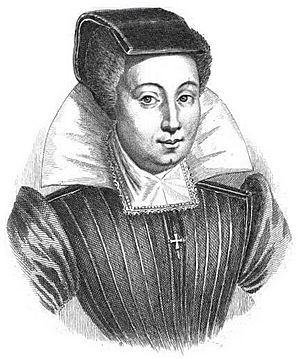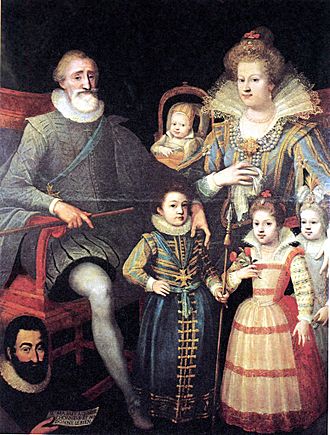Louise Boursier facts for kids
Quick facts for kids
Louise Boursier
|
|
|---|---|
 |
|
| Born | 1563 Faubourg Saint-Germain
|
| Died | 1636 (aged 72–73) |
| Citizenship | French |
| Education | Diploma and license to practice midwifery |
| Known for | Scholarly writings on midwifery, midwife to French royal family |
| Spouse(s) | Martin Boursier |
| Scientific career | |
| Fields | midwifery |
| Institutions | court of Henry IV of France |
| Patrons | Queen Marie de Médicis and French King Henry the Great |
Meet Louise (Bourgeois) Boursier (1563–1636)! She was a very famous French midwife who helped deliver babies for many women. She even worked for the royal family! Louise delivered all six children of Marie de Médicis, who was the wife of King Henry IV of France.
Louise earned a lot of money, about ten times more than other midwives at the time. She was also known as a smart scholar and teacher. Through her writings and practical methods, she helped make midwifery a respected medical field. She was the first woman to write a book about obstetrics, which is the study of childbirth. Her books were used by doctors and midwives in many countries.
Contents
Early Life and Family
Louise Bourgeois was born in 1563 in a farming area near Paris, France. Her family was not noble, but her father was a builder. They were part of the growing middle class and Louise received a good education.
Louise married Martin Boursier, a medical professional called a barber-surgeon, in 1584. They moved to Faubourg Saint-Germain and had three children. Their life was comfortable until 1589, when King Henry IV attacked Paris.
At that time, Louise was home alone with her children while her husband was away with the army. She had to leave their home and most of their belongings to find safety inside the city walls of Paris. To earn money, Louise started doing needlework and selling embroidered items. This was barely enough to support her family. This difficult time eventually led her to become a midwife.
Becoming a Midwife
When Louise's husband returned around 1591, his income as a doctor was not enough for their family. After her third child was born, her nurse suggested she become a midwife. Louise started working part-time in the 1580s. By 1593, she became a professional member of the Guild of Midwives.
She learned a lot about childbirth from her husband's writings and from another famous surgeon, Ambroise Paré. Louise also attended a new college for midwives at the Hôtel-Dieu de Paris hospital. She was one of the first students to graduate from this school. Being married to a surgeon helped her learn advanced techniques. This made her stand out from other midwives.
A Royal Career
Louise Bourgeois took a different path to becoming a midwife. Most women became midwives after they had their own children. They would usually learn by working with an experienced midwife. Louise, at age thirty-one, observed the work of Ambroise Paré for five years. She also helped women from lower and middle-class families.
On November 12, 1598, Louise passed her exam and received a license to practice midwifery legally. A panel of doctors, surgeons, and experienced midwives judged her. After this, she moved her family to a nice house in the Latin Quarter of Paris. There, she built a large practice and became very well-known. She helped deliver about two thousand babies and was well-liked. Her connections with important women and doctors in Paris helped her career grow.
Louise was known as a scholar because she wrote down her advanced knowledge. She and her husband started a small medical business and pharmacy that stayed in their family for many years.
In 1600, King Henry IV married Marie de' Medici. Their first child was due in 1601. The King first wanted another midwife, Madame Dupuis. But Louise convinced King Henry IV that she was the best choice. She had already helped many young ladies of the Royal Court. Just three years after getting her license, she became the official royal midwife! Louise felt this was a gift from God.
She wrote about her experience with Queen Marie's first childbirth in her 1617 book. She proudly called herself "the first woman of my art to take pen in hand." As the royal midwife, the King respected Louise as much as his own doctors. After the successful birth of their first son, Louis XIII, Louise became very famous. She then published many books about pregnant women, medicine, and diagnosing illnesses.
Louise was the midwife for Marie de' Medici's six children, born between 1601 and 1610. For each son she delivered, she was paid 500 crowns. For each daughter, she received 300 crowns. This was a lot of money, as the average midwife earned only 50 crowns per delivery. Louise worked as a royal court midwife for over twenty-six years.
Later Life and Writings
In 1608, Louise received a large payment of 6,000 livres for her services. After the birth of the last royal child, Henrietta Maria, Louise asked for a yearly pension of 600 livres. King Henry IV agreed to 300 livres in 1610, which was a good retirement income.
Even though she was retired from her royal duties, Louise continued to write. She made important contributions to the field of obstetrics. In 1609, she wrote a book called Various Observations on the Sterility. This was the first book on midwifery written by a woman. It included her advice for her daughter. She also shared her thoughts on why women sometimes preferred male doctors over midwives. Later editions of her books included more techniques and information. Her descendant, Angelique le Boursier du Courdray, who was also a royal French midwife, added to these works in 1759.
In 1627, Louise helped deliver the child of Princess Marie de Bourbon-Montpensier. Sadly, the princess died after giving birth. Male doctors, who were often rivals of midwives, wrote a report that suggested Louise was at fault. Louise strongly disagreed with their report. She wrote a defense called "Apology of Louise Bourgeois." In it, she explained her many qualifications and how she had practiced midwifery for thirty-four years. She highlighted that she had earned her proper certificate and written books used by doctors in many countries. She proudly stated she was the first female midwife to write on the subject. Eventually, this difficult situation led to the end of her career as a midwife.
Despite this setback, Louise Bourgeois achieved many great things in medicine. She was a famous author and midwife for royal families. She helped midwives gain more respect in the medical world.
Important Books
Louise Bourgeois wrote five medical books between 1609 and 1634. She believed that all midwives should use the practical information in her books. Her first book on midwifery and childbirth had useful information about obstetrics. There were not many books like it at the time. This book mentioned about 2000 childbirth cases. It was published in Latin, German, Dutch, and English until the 1700s.
Her first expanded book included a short story about her life. Later editions had medical cures for skin problems and pain. Her first three books were different volumes titled Diverse Observations on Sterility, Miscarriage, Fertility, Childbirth, and the Diseases of Women and Newborn Children.
- 1609 - Various Observations on the Sterility: A medical textbook with steps for midwifery procedures. It included stories about difficult deliveries.
- 1617 - Diverse Observations: An expanded version of her obstetrical ideas with more medical recipes and 'Advice to my Daughter'.
- 1626 – Diverse Observations: Another expanded version with treatments for anemia. It also shared details about her journey to becoming the Queen's midwife and her first royal delivery.
- 1634 – Collection of Secrets: An expanded version with advice on a technique called podalic version.
- 1642 – Diverse Observations: An expanded version with guidelines for infant care.
- 1652 – Diverse Observations: An expanded version with more treatments.
See also
 In Spanish: Louise Bourgeois Boursier para niños
In Spanish: Louise Bourgeois Boursier para niños


